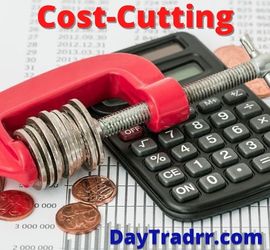What Is Cost-cutting?
 Cost-cutting occurs when an organization strategically reduces expenditures and directly implements measures to improve profitability. Measures implemented by a corporation to cut costs and expenses while boosting profitability are referred to as cost reduction. These steps are often taken when a company is in financial difficulties or during an economic slump. They can also be implemented if a company’s management anticipates future profitability concerns. In that case, cost-cutting might become part of the corporate strategy.
Cost-cutting occurs when an organization strategically reduces expenditures and directly implements measures to improve profitability. Measures implemented by a corporation to cut costs and expenses while boosting profitability are referred to as cost reduction. These steps are often taken when a company is in financial difficulties or during an economic slump. They can also be implemented if a company’s management anticipates future profitability concerns. In that case, cost-cutting might become part of the corporate strategy.
The most typical motive for a company to decrease expenses is to increase profits. However, there are other reasons to implement a cost-cutting program. For example, if a company wishes to fund new technology or expansion into a new market. It can minimize existing costs rather than obtaining funds elsewhere. In order to compete more successfully in its industry, a business may seek to minimize expenditures.
Cost-cutting implies deliberate actions taken by an organization to minimize its costs. In severe instances, businesses may implement a number of cost-cutting initiatives in order to return to profitability. Cost-cutting solutions frequently include decreasing travel and adopting energy-efficient practices.
Cost-cutting – A Closer Look
Shareholders seek tangible monetary returns on their investments. As a result, they anticipate that management will maintain profit growth. Most companies can generally produce profit growth while the business cycle is on the rise. However, during a downturn, profits may decline, and remain low for an extended period of time, Management may feel pressure from shareholders to slash costs in order to shore up the bottom line.
Laying off employees, reducing employee pay, closing facilities, and streamlining the supply chain are all examples of cost-cutting measures. Also, downsizing to a smaller office or moving to a less expensive building or area, and reducing outside services. Implementing new technology can also be viewed as a way to save money. For example, new equipment may replace a particular number of employees, lowering labor expenses. The cost of the machine is recouped over a set amount of time without incurring labor expenditures.
Cost-cutting Strategy
Before cutting costs indiscriminately, it is critical to adopt a comprehensive cost-reduction strategy. Some expenditures are unavoidable, so it is critical to categorize costs accordingly. Some costs are positive. They are focused on the company’s growth or connected with the company’s clients and how to meet their needs. Negative costs are those that are unrelated to the company’s growth targets and squander resources. When negative costs are reduced, resources that could be used more productively become available. Untouchable costs are those linked with what distinguishes a company and how it stands apart from the competition. These costs support brand recognition and give actual value to the customers.
A corporation must first identify and designate its costs. Then, it will be easier to focus on decreasing negative costs and maximizing positive costs. It’s also worth noting that cost-cutting does not always imply totally eliminating an expense. It can also relate to efficiency and optimization. Because increasing productivity lowers costs, it is critical to track productivity. For example, there are now apps that allow businesses to track staff productivity. Also, the time spent on specific tasks and projects.
Cost-cutting versus Cost Control
Most enterprises want to maximize their profit, which is possible by decreasing the production cost. For this purpose, management has two efficient tools – cost control and cost reduction. Cost Control is a technique where the necessary information is available to management. It reveals whether actual costs are aligned with the budgeted costs or not. Cost-cutting is a technique used to reduce the unit cost of the product without compromising its quality.
Cost Control
Cost control is a procedure that focuses on monitoring and controlling overall costs through competitive analysis. It is a method of aligning actual costs with defined production standards. It ensures that the cost of production does not exceed a certain limit. Cost control entails a series of tasks that begin with the creation of a budget for manufacturing. Actual performance is measured by calculating the differences between actual and budgeted costs. Corrective action is taken when needed to rectify discrepancies. Standard costing and budgetary control are the two most important cost-control approaches. It is a continuous procedure that aids in the analysis of variance causes. For example, control material waste, any embezzlement, and so forth.
Cost Reduction
Cost reduction is a strategy that seeks to reduce the unit cost of a manufactured product or service. However, without compromising its quality. It is possible by employing new and improved approaches and procedures. Further, it involves identifying alternative methods to minimize a unit’s production cost. Thus, cost reduction ensures per-unit cost savings and corporate profit maximization. Cost reduction tries to eliminate excessive expenses wherever and whenever they may arise. For example during the manufacturing, storage, selling, and distribution of the product.
Cost-cutting – Risks and Pitfalls
Wages and salaries are major categories of expense. As a result, many businesses turn to layoffs first as a cost-cutting tool when times are tough. However, there are hidden or prospective expenses connected with terminating someone. For example, severance compensation, unemployment benefits, rehiring fees, and wrongful termination claims. Moreover, there is the potential for morale loss and the risk of overworking existing employees.
Furthermore, if the business rebounds faster than management anticipated, the company may face a personnel shortage. In that instance, it would be at a competitive disadvantage in an improving business environment. Shuttering a factory as part of a cost-cutting exercise cannot be easily undone. Then, the corporation may not have the manufacturing capacity to respond to a sudden spike in orders. This all illustrates the importance of a corporation having a solid and adaptable cost-cutting strategy.
Cost-cutting Example
- Review existing expenses
- Adopt a strategy – Seek input and avoid across-the-board cuts
- Cut duplication first
- Upgrade technology, operations, and efficiency where possible
Here’s an illustration of how things might go awry. Consider a multi-national firm that wanted to save money quickly. They began by determining the amount of savings required rather than auditing and understanding current expenses. Instead, they simply required each department to cut costs by a similar proportion. This was achieved mostly through headcount reductions ranging from 15 to 25 percent.
However, the reality was that the corporation needed to invest more in certain rapidly changing technological sectors. They also needed to upgrade operations, where performance was well behind industry averages. Furthermore, because different tiers of the business were doing identical tasks, the HR and IT divisions substantially duplicated certain activities. As a result, much bigger cuts in these functions might be implemented with little strategic risk. However, the company had already chosen to cut expenditures across the board. Just six months later, technology and operations were lobbying hard to bring in more workers. They desperately needed additional headcount to handle an uncontrollable workload. Meanwhile, HR and IT remained heavily duplicative.
Up Next: What Is a Discrete Probability Distribution?
 A discrete probability distribution describes the occurrence of a discrete random variable with a countable value and a non-zero probability. A discrete probability distribution displays the occurrence of discrete, individually countable events like 1, 2, 3,…, or zero vs. one. For instance, the binomial distribution is a discrete distribution. It evaluates the likelihood of a yes or no outcome occurring over a specific number of trials. For example, flipping a coin 100 times and getting heads, given the event’s probability in each trial.
A discrete probability distribution describes the occurrence of a discrete random variable with a countable value and a non-zero probability. A discrete probability distribution displays the occurrence of discrete, individually countable events like 1, 2, 3,…, or zero vs. one. For instance, the binomial distribution is a discrete distribution. It evaluates the likelihood of a yes or no outcome occurring over a specific number of trials. For example, flipping a coin 100 times and getting heads, given the event’s probability in each trial.
Statistical distributions can be discrete or continuous. A continuous distribution is made up of outcomes that fall on a continuum. For example, all values greater than 0 which includes decimals that continue indefinitely. Overall, discrete and continuous probability distributions, as well as the random variables they describe, are the foundations of probability theory and statistical analysis.




